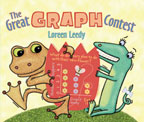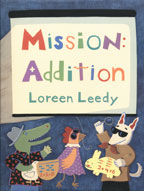Math in Picture Books = Math in Context
As
a student, I was not a math person especially…so how did I end up
writing and illustrating so many math picture books? At that time (late
60s and 70s) math was presented in such an abstract way it was pretty
tough to relate to. To me, it was just a bunch of meaningless numbers that (as presented) had little to do with real life. Though an A or B student, I dropped out of
taking math classes as soon as possible after an "incident" with an overly strict trigonometry teacher. The books I create now are the
kind I wish had been around lo those many years ago…friendly, fun, and colorful. Of course, the very
abstract nature of math means that it's easy to connect math with just
about anything…from silly monsters to graph-making toads to lazy witch
girls to Boston terriers.
Most of my books have a storyline that
puts the math concepts into meaningful context to help kids see why
it's important to be able to add, subtract, and more. Without further ado, here are my math books…click on the book's cover to visit that book's page on my site with activity ideas, reviews, art notes, and ISBN numbers. The links below go to various teaching ideas online. The Common Core State Standards for Mathematics quotes and citations that relate to each title come from the PDF available here.
Follow the Money! shows George the quarter as he makes his way through the economy being spent, saved, lost, and even washed in a washing machine, all in one day. The page numbers are part of the fun…they consist of various coins and bills.
17 page lesson plan from the Office of the Vermont State Treasurer
Mathwire Money Activities & Strategies
Mathwire Money Activities & Strategies
Common Core Math 2.MD.8. Solve word problems involving dollar bills, quarters, dimes, nickels, and pennies, using $ and ¢ symbols appropriately…
The Monster Money Book starts with a young monster and a girl who want to join The Monster Club. They earn money to pay dues and help figure out how to spend the club funds. Several basic personal finance concepts are discussed such as how to earn money, being a smart shopper, investing in a (very) small business, earning a profit, making a budget, and donating to good cause.
The Jump$tart Coalition for Personal Financial Literacy has tons of educational resources, national K-12 standards, state requirements, best practices, and more.
Common Core Math 2.MD.8. (same as above)
The Great Graph Contest begins with a toad named Gonk who loves to make graphs about his interests such as mud, pie, and foot sizes. His lizard friend Beezy challenges him to a graph contest, so they go into the garden to collect and sort data, then make Venn diagrams, bar graphs, pie charts, and more.
Common Core Math: Several Standards apply, such as 1.MD.4. Organize, represent, and interpret data with up to three categories; ask and answer questions about the total number of data points…
It's Probably Penny stars Lisa and her dog Penny, who becomes the focus of a homework assignment about
probability. Lisa predicts the likelihood of events such as whether
Penny will see a shark, dig up a buried treasure, or turn into a cat,
then records the actual results.
The Best Children's Books.org suggests Do the Homework! In other words, use the book itself as a lesson plan.
Common Core Math: I couldn't find a reference to probability prior to 6th grade, but a related concept may appear in lower grades… if anyone knows, please leave a comment.
In Mapping Penny's World Lisa needs to make maps for her homework, so she starts with a floor plan of
her room, complete with symbols, a key, a compass rose, and a scale.
Other maps include Penny’s treasures, her favorite places, and a trip
around the world Penny might take some day.
Common Core Math 4.MD.3 Apply
the area and perimeter formulas for rectangles in real world and
mathematical problems. For example, find the width of a rectangular room
given the area of the flooring and the length…
Also, many of the various measurement standards apply.
In Measuring Penny, Lisa needs to measure something for her homework, so she chooses her
dog Penny and a few of doggie friends at the park. Lisa uses both
standard and nonstandard units to measure tails, paws, noses, as well as
how high the dogs can jump and many other attributes.
Common Core Math: Every primary grade level has measurement standards, such as 2.MD.1 Measure the length of an object by selecting and using appropriate tools such as rulers, yardsticks, meter sticks, and measuring tapes.
Fraction Action features Miss Prime and her students as they learn about fractions in five short stories
that start with simple geometric shapes and objects such as half a glass
of milk. Scenarios such as how to divide food evenly for a lunch or how
far to discount lemonade for sale in wintertime show how fractions are
used in real life.
Common Core Math: Halves and fourths are in 1st grade (1.G.3), thirds in 2nd grade (2.G.3), and fractions as numbers in 3rd grade (3.NF.1–3)
In Mission Addition, Miss Prime explains the basics then her students venture
out into the world to add up scores, tally up their pets, sell things at
a garage sale, and write word problems. Extra problems are at the end of each chapter.
Teaching Addition and Subtraction Facts in First Grade books and online resources
Mission Addition online game (not related to my book)
Common
Core Math: 1.OA.1 Use addition and subtraction within 20 to solve word
problems involving situations of adding to, taking from, putting
together, taking apart, and comparing…
Subtraction Action has seven short stories in which Miss Prime’s students watch a magic show, put on
a play, run an obstacle course, and try to win a prize by making things
disappear.
Common Core Math: 1.OA.1 (Same as above)
Missing Math When a town’s numbers vanish one day, everyone discovers how difficult a
world without math would be. If nobody can count, add, subtract, make
phone calls, use a computer, or use money, life becomes
impossible! Hopefully a local detective can crack the case.
Common Core Math: Many of the standards relate to this book in the sense of how bad it is if you can't count, add, subtract, and so on.
Seeing Symmetry shows a myriad of examples of line and rotational symmetry, from kites to quilts to flowers to animals of many kinds. Symmetry relates to many basic math concepts such as equality, repeats, reflections, and rotations.
Common Core Math: 4.G.3: Recognize a line of symmetry for a two-dimensional figure as a
line across the figure such that the figure can be folded along the
line into matching parts. Identify line-symmetric figures and draw lines
of symmetry.
2 X 2 = BOO! A Set of Spooky Multiplication Stories In six short and silly stories, Halloween characters such as ghosts, black
cats, bats, and skeletons demonstrate the multiplication facts from 0 X 0
= 0 up to 5 X 5 = 25.
Common Core Math: 3.0.7. Fluently multiply and divide within 100…
For an ever-enlarging collection of various teaching ideas for elementary math, please visit my Making Math Fun! board on Pinterest.
That's all folks…whew!











No comments:
Post a Comment
Please leave a comment...I enjoy reading them!